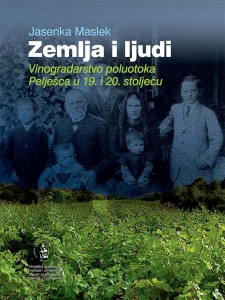 Jasenka Maslek, Land and people: Wine-growing of the Pelješac peninsula in the nineteenth and twentieth centuries. Zagreb-Dubrovnik: Hrvatska akademija znanosti i umjetnosti, Zavod za povijesne znanosti u Dubrovniku: 2016, 264 p.
Jasenka Maslek, Land and people: Wine-growing of the Pelješac peninsula in the nineteenth and twentieth centuries. Zagreb-Dubrovnik: Hrvatska akademija znanosti i umjetnosti, Zavod za povijesne znanosti u Dubrovniku: 2016, 264 p.
This book analyses the development of wine growing on the peninsula of Pelješac and its influence on demographic trends from the fall of Dubrovnik Republic until the end of the twentieth century. The book is divided into eight chapters and traces chronologically the interaction between economic and demographic change, as well as its dependence on various political, social, and cultural processes. The starting point was the cadastre of Francis I which enabled the author to reconstruct the amount of land dedicated to wine growing. The data offered by this cadastre is comprehensive and detailed, and especially important since it reveals that the local wine growing reached its peak in the mid-19th century. This development was largely facilitated by the capital acquired in seafaring, which was often invested in land. Using very diverse sources, ranging from official and statistic data to family memorials, Maslek also reconstructed the everyday life on the late nineteenth- and early twentieth-century Pelješac. Moreover, by analysing the prices of food and wine, the author estimated the purchasing power and financial possibilities of the peninsula’s inhabitants. Interestingly, the author used private family memorials to bridge the lacunae in official statistic data, and successfully reconstruct important issues such as the percentage of vineyards and wine growing. Additionally, the author has illustrated certain local customs by using oral testimonies of the region’s inhabitants.
This important and valuable book has its origin in the doctoral dissertation submitted within the PhD programme “History of the Population” in Dubrovnik. Due to its extraordinary value it has now been published by the Institute for Historical sciences of CASA in Dubrovnik.
Irena Ipšić
